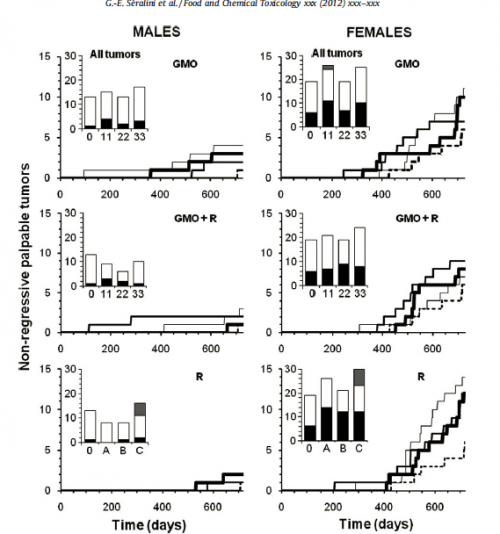This session is on Practicing Food Studies. It will be at 5;00 p.m. Details to come.
What to make of the scary GMO study?
I am a strong supporter of labeling GMO foods. Consumers have the right to know.
That’s enough of a reason to support California’s Prop. 37. There is no need to muddy the waters with difficult-to-interpret science.
My e-mail inbox was flooded with messages yesterday about the new long-term rat study reporting that both GMO corn and Roundup (glyphosate herbicide) increase mammary tumors in mice.
The study, led by Gilles-Eric Séralini, concludes:
The results of the study presented here clearly demonstrate that lower levels of complete agricultural glyphosate herbicide formulations, at concentrations well below officially set safety limits, induce severe hormone-dependent mammary, hepatic and kidney disturbances… the significant biochemical disturbances and physiological failures documented in this work confirm the pathological effects of these GMO and R treatments in both sexes.
These results are so graphically shocking (see the paper’s photographs), and so discrepant from previous studies (see recent review in the same journal), that they bring out my skeptical tendencies. (Note: Although Séralini is apparently a well known opponent of GMOs, his study—and that of the review—were funded by government or other independent agencies.)
For one thing, the study is weirdly complicated. To its credit, it went on for two years (much longer than the typical 90 days for these kinds of studies).
But it involves ten separate groups of 20 mice each (10 males and 10 females) fed diets containing GMO (Roundup-resistant) corn, grown with Roundup or not, or fed control diets (non-GMO corn) with or without Roundup added to their drinking water at three different levels.
I needed a Table to keep this straight.
CONTROL AND TREATMENT GROUPS
| GROUP | %CORNIN DIET | CORN TREATEDWITH ROUNDUPHERBICIDE | GIVEN ROUNDUPTO DRINK |
| Non-GMO Control | 33% | No | |
| GMO Corn | 11% | No | |
| GMO Corn | 22% | No | |
| GMO Corn | 33% | No | |
| GMO Corn | 11% | Yes | |
| GMO Corn | 22% | Yes | |
| GMO Corn | 33% | Yes | |
| Non-GMO Corn | 33% | No | 0.1 ppb (level in tap water). |
| Non-GMO Corn | 33% | No | 0.09% (level contaminating feed) |
| Non-GMO Corn | 33% | No | 0.5% (half the level used in agriculture) |
Complicated studies require careful interpretation. Here are the main tumor results.
LINES: The dotted line is the control. The three corn doses (11%, 22%, 33%) correspond to thin, medium and bold lines, respectively.
BARS: 0 = Control. R = Roundup. A, B, and C correspond to the three levels of Roundup in drinking water.
Besides complications, the study raises several issues:
- Incomplete data: the authors state that “All data cannot be shown in one report and the most relevant are described here.” I’d like to know more about what the control rats ate and whether there were differences in the amounts of diets consumed, for example.
- Lack of dose response: the authors explain that 11% did as much harm as 33% as a threshold effect. This requires further study to verify.
- Statistical significance: The paper doesn’t report confidence intervals for the tumor data (the bars don’t look all that different to me).
The California Prop. 37 proponents (and I’m totally with them) already have a strong “right to know” argument. They don’t need to be distracted by the kinds of scientific arguments that are already raging about this study (see, for example, the British Science Media Centre’s collection of criticisms).
For more information about the study:
The British Sustainable Food Trust has a website devoted to this study.
Tim Carman wrote about it in the Washington Post (I’m quoted)
Andrew Pollack has a sensible piece in the New York Times
France calls for a ban on GM foods
Additional clarification: I very much favor research on this difficult question. There are enough questions about this study to suggest the need for repeating it, or something like it, under carefully controlled conditions.


